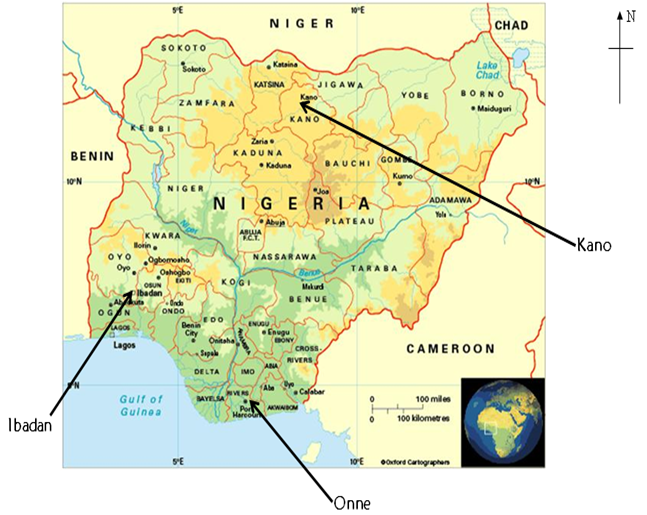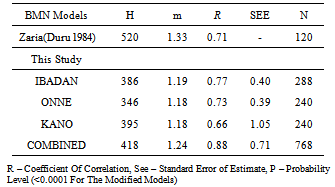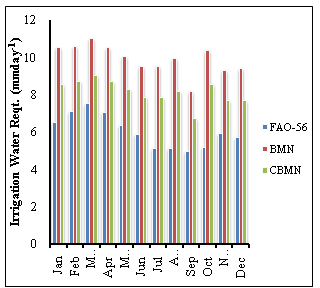Oluwaseun A. Ilesanmi , Philip G. Oguntunde , Ayorinde A. Olufayo
Department of Agricultural Engineering, The Federal University of Technology, P.M.B. 704, Akure, Ondo State, Nigeria
Correspondence to: Oluwaseun A. Ilesanmi , Department of Agricultural Engineering, The Federal University of Technology, P.M.B. 704, Akure, Ondo State, Nigeria.
| Email: |  |
Copyright © 2012 Scientific & Academic Publishing. All Rights Reserved.
Abstract
This study re-examined the BMN model making use of the Sigma Plot software (based on the Levenberg – Marquardt algorithm) to generate modified versions of the BMN model that are specific for Ibadan, Kano and Onne and one version which applicable across the country, correcting some perceived shortcomings of the BMN. Records of climatic variables (Solar radiation, Maximum and Minimum Temperature, Maximum and Minimum Relative Humidity and Wind speed) were collected from three International Institute of Tropical Agriculture (IITA) Stations in Ibadan, Kano and Onne. For Ibadan, a 36-year (1973 – 2008) record was obtained, for Kano, a 29-year (1980 - 2008) record was obtained and for Onne, a 31-year (1977 - 2006) record was obtained. Evapotranspiration rates for each of the stations were then estimated using the FAO56-PM model. ETo estimates from the FAO56-PM model were thereafter used to recalibrate the BMN model, generating new model constants for Ibadan, Kano, Onne and a model combining the climatic characteristics of the three stations. The re-calibrated BMN model had higher correlation values of 0.74, 0.79 and 0.75 for Ibadan, Onne and Kano respectively when compared with the FAO-56 model than the Original BMN model when compared with the FAO56-PM model with values of 0.7, 0.77 and 0.75 respectively for Ibadan, Onne and Kano.
Keywords:
Evapotranspiration, Blaney-Morin-Nigeria, FAO56-PM Model, Levenberg – Marquardt, IITA
Cite this paper:
Oluwaseun A. Ilesanmi , Philip G. Oguntunde , Ayorinde A. Olufayo , "Re-examination of the BMN Model for Estimating Evapotranspiration", International Journal of Agriculture and Forestry, Vol. 2 No. 6, 2012, pp. 268-272. doi: 10.5923/j.ijaf.20120206.01.
1. Introduction
Water is becoming scarce in many parts of the world, Nigeria inclusive. Over the years, it is widely believed that climate change will have a significant impact on the availability of water. A lot of water is needed for agricultural practices and also for domestic purposes. In view of this it is imperative to have the knowledge of the rate at which water is being returned to the atmosphere either form water bodies, reservoirs, land surfaces and from plant bodies. This process is termed evapotranspiration (ET). To determine this rate, different approaches have been developed by scholars over the years for its measurement. These approaches are the direct and indirect measurements. The direct measurement include the use of lysimeters[3], energy balance/budget approach[3];[14];[8], the soil water budget method[15];[6];[7];[8], use of panevaporimeters[4];[18];[10];[20];[19];[13];[9] and the Eddy-Covariance method[16];[17].The indirect measurement involves the use of empirical models which were developed to estimate ET using meteorological data. These models range from simple expressions which relate ET to temperature or radiation to models having extensive data requirement. Models can be classified under three distinct approaches. They are temperature based models which include the Thornthwaite, Blaney-Cridle, Blaney-Morin and McCloud models [11]. The second approach is the radiation based models. Examples of these models are the Turc, Hargreaves, Hargreaves-Samani, Priestly-Taylor and the Makkink Formula[2]. The combination method is the third approach and it is based on the original Penman model which consists of the radiative and the aerodynamic part. This model has been modified over the years because it produces good results when applied over different climatic regions. One of its modification is the FAO56 Penman-Monteith model (FAO56-PM) which has been adjudged to be the best estimator of Reference Evapotranspiration (ETo) and has been adopted as the sole model to be used for the estimation of ETo from meteorological data[2];[1]. Many of these models are subject to local calibration [1], especially the temperature and radiation based models. In view of this, a temperature-based model has been developed, which has been adjudged to be the best for the Nigerian condition by the Nigerian Institute of Agricultural Engineers (NIAE), this is the Blaney-Morin-Nigeria (BMN) model developed by Duru [5]. This model was developed to make ETo estimation in Nigeria easier taking into consideration the commonly available meteorological parameters and the accuracy of its estimation which is credible.In the development of the Blaney-Morin-Nigeria model for estimating ET by Duru [5], there were some perceived shortcomings which may affect the reliability of its estimation in Nigeria. Some of the criticisms which this study is aimed at correcting include; • The use of data from a single location in Nigeria for the development of the model;• The use of a ten-year data for the model development;• The choice of pan evapotranspiration estimates as the basis for reference (although this was acceptable at that time; and• The application of manual iteration during its development which is prone to human error.This study intends to re-examine theBlaney-Morin-Nigeria model with a view to modifying it for improved performance across the country and generating location specific model constants for Ibadan, Kano and Onne.
2. Materials and Methods
2.1. Study Area
This study covers the whole of Nigeria with specific emphasis on three cities, Ibadan, Kano and Onne (Figure 1) where IITA stations are located. It lies within latitudes 4oN – 14o N and Longitudes 2oE – 15o E.The country has an estimated population of 138,283,380 people (2008 estimates, Source: Wikipedia) and a total land mass of 923,768km2 (the 32nd largest country in the world) with about 1.4% of this land mass covered by water.Special emphasis is placed on three location having distinct characteristics into which the climatic and agro-ecological conditions of the country can be divided. They are:i. Onne (4°45′0″N, 7°00′0″E); near Port Harcourt having a humid climate characterized by swamps, heavy rainfall and mangrove forests. The region’s soil is Thionic Fluvisol, having a mean annual rainfall of 2400mm, a unimodal rainfall pattern with annual maximum temperature ranging from 28-32℃ annual minimum temperature ranging from 21-23℃. It also has two distinct seasons; the lengthy and heavy rainy season and very short dry season. The rainy season spans February to November while the dry season occurs in the remaining months although precipitation of about 20mm do occur during this period. | Figure 1. Map showing Study Area |
ii. Ibadan (7°23′47″N 3°55′0″E); is also one of the locations. It has a sub-humid climate which is characterized by rain forests and slightly heavy rainfall. Its rainfall pattern is Bimodal with mean annual rainfall of 1250mm. The region’s soil in majorly Ferric Luvisols, its season are wet which from March through October and dry running through November to February having annual maximum temperature ranging between 27-34℃ and annual minimum temperature ranging between 20-23℃. Both regions mentioned above are characterized with light wind speeds. (Oguntunde, 1998).iii. The third location is Kano (12°00′0″N 8°31′0″E) which is situated in the northern region of the country. It has a semi-arid or savannah climate characterized with scattered trees and shrubs. The region has a high wind speed which carries large deposits of sand that are deposited in the area to replenish the soil removed by erosion. It has Ferric Latosol soils and the region has an annual mean rainfall of 748.1mm between 1988 and 2001. Its season can be divided into two, the wet/rainy season which occurs between May and September with temperature ranging between 24℃-29℃ and the dry season between October and April with maximum temperature range between 28℃-34℃ and minimum temperature range between 25℃-27℃.
2.2. Data Source
Records of climatic variables (Solar radiation, Maximum and Minimum Temperature, Maximum and Minimum Relative Humidity and Wind speed) were collected from three International Institute of Tropical Agriculture (IITA) Stations in Ibadan, Kano and Onne. For Ibadan, a 36-year (1973 – 2008) record was obtained, for Kano, a 29-year (1980 - 2008) record was obtained and for Onne, a 31-year (1977 - 2006) record was obtained. Data collections were done by IITA trained personnel and weather instruments installations conform to WMO standard. Agro-ecological characteristics of the sites and instrumentation are presented in Jagtap and Alabi (1997).
2.3. Model Re-Examination
The Blaney-Morin-Nigeria Model is of the form | (1) |
rf = ratio of monthly radiation to annual radiationTa = mean monthly temperature in℃R = mean monthly relative humidityH and m are model constants of 520 and 1.31 respectivelyThe procedure used for the generation of model constants for Ibadan, Onne and Kano is as described in Duru (1984), but ETo estimates used for the re-examination was obtained using the FAO56-PM model. Thereafter, a non-linear regression model based on the Levenberg-Marquardt Algorithm (Sigma-Plot) was used to generate new model constants for Ibadan, Kano, Onne and a set of model constants also generated for a combined meteorological data from the three locations.ETo estimates from the generated model constants were then compared against ETo estimates from the FAO56-PM model using the following statistic parameters, the Mean Bias Error (MBE), Measurement of the variability of the difference between the predicted and observed values (S2d), Mean Absolute Error (MAE), Root Mean Square Error (RMSE) and the Coefficient of Correlation (r).
3. Results and Discussions
The newly generated model constants for the BMN model are shown in Table 1. The values of the model constants generated are significantly lower than that of the original model. The form of the re-examined models for each station is also shown below. Table 2 and 3 shows the outcome of the statistical comparison between the FAO56-PM model against the newer models at each station and the combined model at each station. The r values of the new Ibadan, Kano and Onne BMN models were 0.74, 0.75 and 0.78 respectively, the combined BMN model gave r values of 0.70, 0.75 and 0.77 for Ibadan, Kano and Onne respectively. The original BMN model has r values of 0.71, 0.64 and 0.72 respectively for Ibadan, Kano and Onne stations. The correlation value of the Modified BMN Model (BMNcombined) is 0.88 as against 0.71 obtained by the Original BMN model (Duru, 1984) The higher r values of the new models as against the old BMN model showed that the newer models provides better estimates of ETo than the old model taking into consideration the outcome of the other statistic parameters used. In all the stations overestimation of ETo values by the BMN models against ETo values from the FAO56-PM model were observed. In Ibadan, the BMN yielded an overestimation of 8.2%, BMNIbadan yielded an overestimation of 3.2% while the BMNCombined gave an overestimation of 4.4%. In Kano, the BMN underestimated ETo to the tune of 12.3% while the BMNKano yielded an overestimation of 1% and the BMNCombined and overestimation of 10.5%. For Onne, the overestimation observed is as follows, BMN (+20.8%), BMNOnne (+2.8%) and BMNCombined (+9.1%).This shows that the location specific models outperformed the BMN and BMNCombined models across the stations because most temperature based models are location specific and subject to localized calibration for improved application (Adeboye et al., 2009), although the BMNCombined model fared better than the BMN model in all the stations. Across the stations, the BMN yielded more ETo overestimation than the BMNCombined, which also yielded ETo overestimations than the location specific BMN models. According to Duru (1984), “from a design and safety standpoint, a model that over predicts should be preferred to one that under predicts and the better model is one that over predicts to a lesser degree”. This implies that the location specific models of Ibadan, Kano and Onne are better estimator of ETo for the stations than the BMNCombined, and the BMNCombined a better model than the BMN wherever they are both applied.Table 1. Generated parameters for the New Blaney-Morin-Nigeria Models
 |
| |
|
The re-examined BMN equations are of the form; | (2) |
 | (3) |
 | (4) |
 | (5) |
Table 2. Summary of Statistical parameters for validation of the New Blaney-Morin-Nigeria models
 |
| |
|
Table 3. Comparison of Statistical parameters for the New BMN models and the Old BMN model at the stations
 |
| |
|
The BMN and the BMNCombined models were thereafter applied to predict the Irrigation water requirement for maize in Akure (Figure 2). From the obtained results, the r values obtained from comparison to FAO56-PM model are 0.71 for the BMN and 0.72 for the BMNCombined. The models also yielded the following overestimations, BMN (+63.5%) and BMNCombined (+34.7%). This supports the claim that the BMNCombined is a better model than the BMN model when they are both applied. | Figure 2. Mean Daily Irrigation Water Requirement For Maize (Akure) Using Sprinkler System (Cbmn – Modified Blaney-Morin-Nigeria Model) |
In view of the above, the study recommends the use of the combined BMN model as the modification of Duru’s model under Nigerian condition.
4. Conclusions
This paper outlined the effect of the corrections done to the old BMN model for the estimation of evapotranspiration, from the results obtained during the data analysis; it was proven beyond doubts that making use of a larger pool of data for model and formula development produces more accurate results. The location specific models proved to be more accurate estimators of ETo when applied at their locations. The modified BMN (BMNcombined) model by implication is also a better estimator across the locations than the BMN and can always be applied in its place when needed all over the country. This is because this work applied standard statistical models in its calibration rather than the manual iteration method previously used. The overall result indicates that the Blaney-Morin-Nigeria model is location specific and that newly generated models fared better and has improved performances than the BMN across the stations considered for this study.
References
| [1] | Adeboye, O.B., Osunbitan, J.A., Adekalu, K.O., Okunade, D.A. (2009). “Evaluation of FAO-56 Penman Monteith and Temperature Based Models in Estimating Reference Evapotranspiration”. Agricultural Engineering International: the CIGR Ejournal. Manuscript number 1291. Volume XI. |
| [2] | Alexandris, S. Stricevic, R and Petkovic, S. (2008). Comparative analysis of reference evapotranspiration from the surface of rain fed grass in Central Serbia, calculated by six empirical methods against the Penman-Monteith Formula. European Water 21/22: 17-28. |
| [3] | Allen, R. G., Pereira, L. S., Raes, D. and Smith, M. “Crop evapotranspiration: Guidelines for computing crop requirements.” Irrigation and Drainage Paper No. 56, FAO, Rome, Italy. |
| [4] | Ayoade, O. A. (1988). Tropical hydrology and water resources. Macmillan publishing, London, 10-25. |
| [5] | Duru J.O. (1984). Blaney-Morin-Nigeria evapotranspiration model. Journal of Hydrology 70: 71-83. |
| [6] | Evett, S. R. (2007). An overview of soil water sensing technologies and problems. Abstract in Intl. Soil Moisture Sensing Technology Conference: Current and future research directions in soil moisture sensing. Honolulu, Hawaii: University of Hawaii, Manoa. |
| [7] | Evett, S. R., and G. W. Parkin. (2005). Advances in soil water content sensing: The continuing maturation of technology. Vadose Zone J. 4(4): 986-991. |
| [8] | Farahani, H. J., Howell, T. A., Shuttleworth, W. J. and Bausch, W.C. (2007). Evapotranspiration: Progress in measurement and modeling in agriculture. SW6926, ASABE, 50(5): 1627 – 1638. |
| [9] | Gavilan, P., Berengena, J., and Allen, R. G. (2007). Measuring versus estimating net radiation and soil heat flux: Impact on Penman-Monteith reference ET estimates in semiarid regions. Agric. Water Mgmt. 89(3): 275-286. |
| [10] | Howell, T. A., Schneider, A. D., and Jensen, M. E. (1991). History of lysimeter design and use for evapotranspiration measurements. In Proc. ASCE Intl. Symp. Lysimetry: Lysimeters for Evapotranspiration and Environmental Measurements: 1-9. R. G. Allen, T. A. Howell, W. O. Pruitt, I. A. Walter, and M. E. Jensen, eds. New York, N.Y.: ASCE. |
| [11] | Jacobs, J. M. and Satti, S. R. (2001). Evaluation of reference evapotranspiration. Methodologies and AFSIRS Crop Water Use Simulation Model (Final Report). Department of Civil and Coastal Engineering, University of Florida, Gainesville, Florida. |
| [12] | Jagtap, S. S., Alabi, R. T. (1997). Reliability of daily, weekly and monthly evapotranspiration using hourly estimates by penman method in three agro-ecological zones of West Africa. Nigerian Meteorological Journal, 2(1): 59-68. |
| [13] | Jia, X., Dukes, M. D., Jacobs, J. M., and Irmak, S. (2006). Weighing lysimeters for evapotranspiration research in a humid environment. Trans. ASAE 49(2): 401-412. |
| [14] | Oguntunde, P. G. (1998). Evaluating the methods of estimating evapotranspiration potential in humid and sub-humid stations of Nigeria. M.Eng. Thesis, Federal University of Technology, Akure, Ondo State, Nigeria. |
| [15] | Phene, C. J., Reginato, R. J., Itier, B., and Tanner, B. R. (1990). Sensing irrigation needs. In Management of Farm Irrigation Systems: 207-261. G. J. Hoffman, T. A. Howell, and K. H. Solomon, eds. St. Joseph, Mich.: ASAE. |
| [16] | Shuttleworth, W. J. (1993). Evaporation. In handbook of hydrology. D. Maidment, ed., New York, N.Y.: McGraw-Hill. |
| [17] | Shuttleworth, W. J. (2007). Putting the “vap” into evaporation. Hydrol. Earth System Sci. 11(2): 210-244. |
| [18] | Xu, C., Gong, L., Jiang, T., Chen, D., and Singh. V. P. (2006). Analysis of spatial distribution and temporal trend of reference evapotranspiration and pan evaporation in Changjiang (Yangtze River) catchment. Journal of Hydrology (2006) 327: 81-93. |
| [19] | Yang, J., Li, B., and Liu, S. (2000). A large weighing lysimeter for evapotranspiration and soil water & groundwater exchange studies. Hydrol. Processes 14(10): 1887-1897. |
| [20] | Young, M. H., Wierenga, P. J., and Mancino, C. F. (1996). Large weighing lysimeters for water use and deep percolation studies. Soil Sci. 161(8): 491-501. |








 Abstract
Abstract Reference
Reference Full-Text PDF
Full-Text PDF Full-Text HTML
Full-Text HTML

